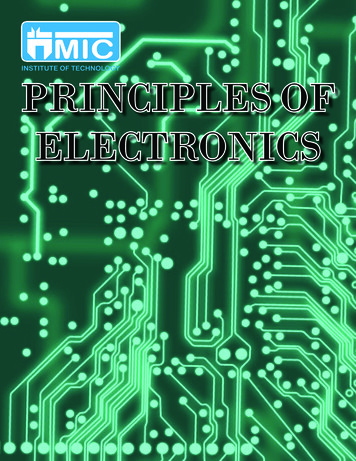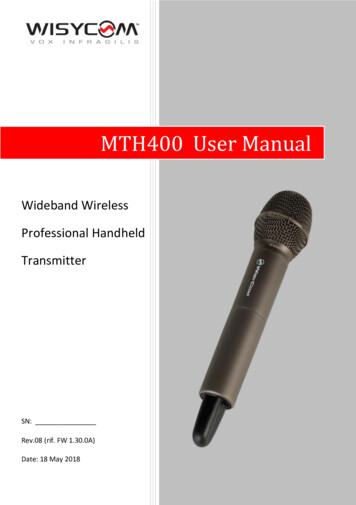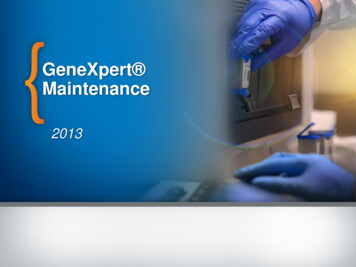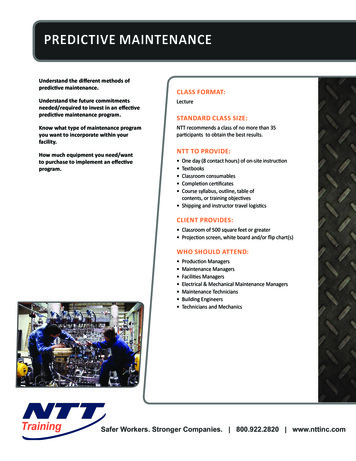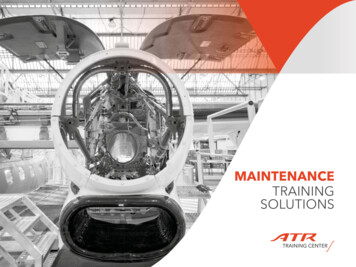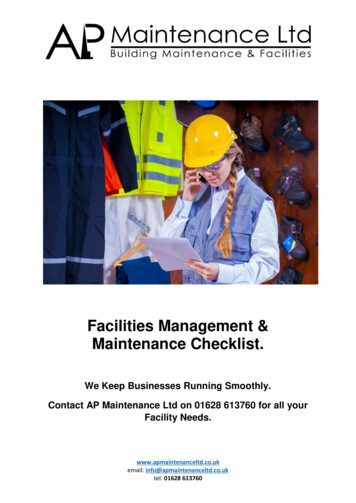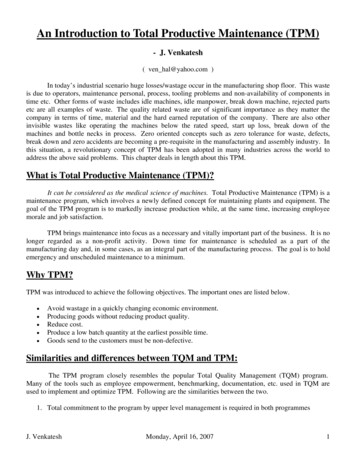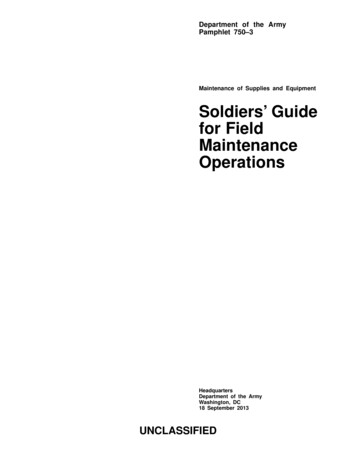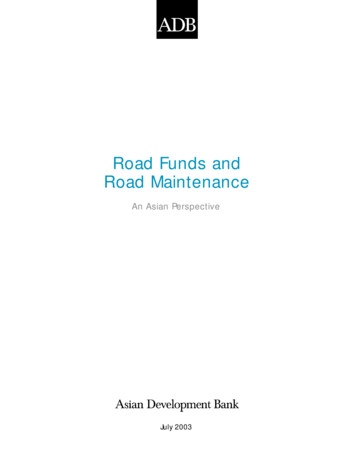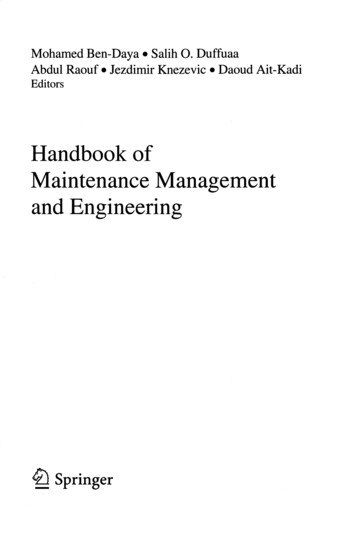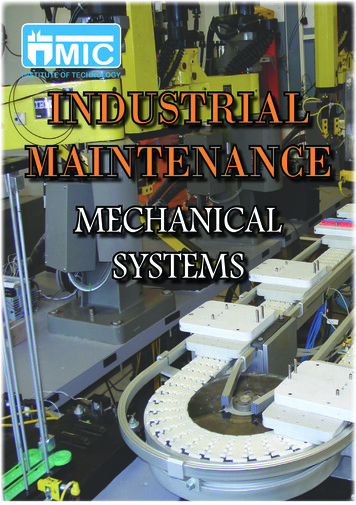
Transcription
INDUSTRIALMAINTENANCEMECHANICALSYSTEMS
FOREWORDMechanical systems provide the most fundamental platform for all heavy industrial plantand is the absolute requirement for all systems requiring movement today.MIC has produced this book for use in its Industrial Maintenance Mechanical SystemsEvening Programme and it is specifically designed to introduce the basics of mechanicalfitting.This book is intended for use as a course text to be supplemented by notes and explanations and does not stand alone.Compilation of this book was completed with standard published material, Tel-A-Train, andresource personnel at MIC. No claim is made to the ownership of any material containedherein.THIS BOOK IS NOT FOR SALELionel Owen October, 1992 Compiled by: Lionel Owen
INTORDUCTIONThe primary purpose of mechanical fitting is to transmit forces across parts of a systemwith as little loss as possible and with minimum of wear. The better the fits the more efficient the system. The primary units required to be fitted are gears, clutches, couplings, beltand chain drives and bearings.To produce these forces there are four main units: pumps, compressors, turbines andlevers. The major aspects of these devices will be discussed in relation to proper maintenance procedures, fault-finding methods and fitting techniques. The information given canbe applied in almost every instance of maintenance fitting and will provide a spring boardfor acquiring more advanced techniques and knowledge in the areas outlined. Where specific areas have not been covered the methods and information given can be interpolatedto fit the circumstances at the time.
MAINTENANCE AND SAFETY1. Ensure all safety devices are operational; test for faults2. Keep all guards in place3. KEEP IT CLEAN at all times during and after maintenance4. Ensure all instruments are accurate; test regularly5. Bench lights must be adequate and functional6. Maintain the integrity of all tools7. Ensure proper and correct lubrication at all times8. Use the correct filters (size and type) and ensure that they are properly installed9. Ensure all locks and fixtures are functional10. Always use the correct tool for the job11. Monitor wear and tear on all moving parts e.g. chains, belts bearings, shafts etc.12. Ensure all connections are tight, clean and correctly identified where applicable13. Ensure all switches operate correctly14. Ensure there are no conductive particles where there are electrical conductors15. Check that all indicators are working16. Check for damaged insulation material17. Ensure that the equipment is protected against hostile environments18. Always be a TEAM MEMBER; one man bands are prone to error19. Always use the correct and prescribed protection devices20. Use logical priorities not emotion; e.g., (1) safety, (2) schedule (3) age, (4) opportunity21. NEVER wear jewellery or long open hair
BRAKES&CLUTCHES
BRAKES AND CLUTCHES1. OperationBrakes resist torque; clutches transmit it.Brakes are used in machinery to create tension, to limit or reduce the speed of rotatingparts, or to hold them stopped. Clutches transmit a driving force to make a machinemove. Most brakes and clutches handle rotational or twisting force, called torque.BrakesMany common brakes resist torque by friction. A rotating part is pushed against astationary part, and there is rubbing or sliding friction between them. If the rotating partstops, static friction holds it stopped.A brake with high friction can stop a big load fast, and hold it stopped firmly. It canprovide more tension in a winding machine.Sliding friction produces heat.In most brakes, the mechanical energy of the rotating part is converted into heat energy by friction. The faster the rotating part turns, and the greater the torque the brakeis resisting the quicker the brake will heat up.
ClutchesClutches connect or disconnect input and output.The input and output of a clutch can be a shaft, pulley, sheave, sprocket, gear, or anyother rotating part. In many common clutches, input and output parts are squeezedtogether; friction transmits torque and the output moves.If input and output parts are pressed together hard enough so that they rotate at thesame speed without slipping, the clutch is fully engaged, or locked up. Torque is transmitted by static friction.If the output is being pressed against the input, but is not rotating at the same speed,the clutch is slipping. Sliding friction is transmitting the torque in this case. Like a brake,a slipping clutch will heat up from the friction that converts rotating power into heat.There are many ways that brakes resist torque, and many ways clutches transmit it.There are also a variety of ways that brakes and clutches can be operated. Effectivemaintenance and troubleshooting require familiarity with how specific units work andwhat they are used for.
Positive Engagement UnitsPositive engagement units do not allow slip.Positive engagement brakes either hold something stopped or let it turn freely. Similarly,positive engagement clutches are either locked up or free. There is no sliding friction inpositive engagement units, and no heat generation.There are many kinds of positive engagement brakes and clutches. Sane engage or disengage themselves automatically. Others are actuated by something external, like a manuallever or air pressure. Some will resist or transmit torque in both directions, others will not.Bi-Directional UnitsBi-directional units work in both directions.Bi-directional brakes and clutches will resist or transmit torque whether parts are turningforward or backward.BrakesA stationary pawl or dog that can engage a cogged wheel is one kind of positive engagement brake. Since it cannot slip, it can only hold something stopped; it cannot limit orreduce speed like most brakes.If the input is turning when the brake is engaged there will be clashing and shockloads.
Applications. Positive engagement brakes are used for:. Accurate and repeatable positioning of parts being machined. Locking of spindles, chucks, and face plates for tool changing. Parking locks for movable equipment and vehicles.Without slip, there will be no friction, heat or wear.Troubleshooting. There is not much that can go wrong with this kind of device if it is always engaged when the input is already fully stopped. Forced engagement when the inputis turning will wear or break the teeth and pawl.Sometimes the pawl or engaging tooth is rounded and engaged by a spring. This allows itto bump along over the wheel teeth if the input it turning. Too much bumping may wear theteeth so that the pawl jumps out of engagement underload.ClutchesDog, jaw, or tooth clutches connect or disconnect parts that are stopped or rotating atthe same speed. Clashing or shockloads will result if they are engaged when input andoutput speeds are not the same.
Positive engagement clutches are like quick disconnect couplings.Applications. The following list describes some of the uses for positive engagementclutches:. Selective connection of motors or shafts to gears, pulleys, or other shafts. Gear changes or reversing in light duty, slow speed equipment, where rotating mass issmall and slight clashing can be tolerated. Synchromesh mechanisms, where a tooth clutch locks input to output only after they arebrought to the same speed by some kind of friction clutch. Overload Protection. Some units are intended to jump out of engagement automaticallywhen too much torque goes through them. Some require a manual reset. Others automatically lock up again after one revolution.Engagement problems are common.Troubleshooting. If a non-overload unit does not go into mesh easily, or jumps out ofmesh, it is probably due to:. Tooth or jaw wear from too much clashing. Misalignment of input and output. A worn shift collar, yoke, or bearing. Worn or misadjusted operating linkage can also beresponsible. Defective overcenter springs or detent parts. Many units include these devices which areintended to keep them either engaged or disengaged.If an overload unit jumps out of mesh, it probably means the load is too large. Do not justtighten up the torque adjustment without checking the specification.One-Way UnitsOne-way units either engage or disengage when their rotation isreversed.One-way positive engagement brakes prevent rotation in one direction and allow free rotation the other way. One-way positive engagement clutches lock up when torque is appliedin one direction and disengage when torque is applied in the other direction. There arevarious mechanisms that provide one-way operation.RatchetsA ratchet holds or releases, depending on which way the wheelturns.Ratchets are used in low-speed machinery. They are likely to be noisy and to wear quicklyduring overruning, as the ratchet pawl rides over the wheel teeth. The wheel may need toreverse direction as much as a full tooth before lockup, so precision is limited.Ratchets should be checked for broken or rounded teeth and a broken, worn, loose, orrounded pawl. A broken pawl engaging spring may cause erratic engagement.
Roller and Sprag/Cam UnitsA roller or sprag/cam unit can be used either as a brake or a clutch. It will lock up withalmost no lost motion, and will handle high torque and speed. Overrunning friction, wear,and noise are low.Rollers or sprag/cams can wedge anywhere instantly.The principle of operation in both roller and sprag/cam units is the same. If the input andoutput elements try to turn so the rollers or sprag/cams jam between them, the unit willlock up. If the input and output elements turn so the rollers or sprag/cams push out of theway, the unit will disengage.ApplicationsOne-way positive engagement clutches and brakes are used in many kinds of equipment:. As a backstop or hold back brake on an elevator or conveyor to prevent downward motion in case power fails. As an overrunning or freewheeling clutch to allow the output to turn faster than the input.A bicycle drive is an example; the rider can stop pedalling while the bike coasts. As an auxiliary or inspection drive that allows two or more power sources to turn thesame equipment independently. If one motor stops, its clutch freewheels while the load isdriven by another power source.Maintenance of Sprag/Cam and Roller UnitsUse the right amount of the right oil or grease.Many sprag/cam and roller clutches are lubricated and sealed for life, and require nomaintenance other than periodic inspection for leakage.Large, heavy-duty units, however, sometimes have oil reservoirs built in. Follow themanufacturer’s recommendations, and do not overfill with oil. Usually half full is enough.Too much oil will get in the way and increase overrunning friction and heat build-up. Oil withextreme pressure additives may cause the sprag/cams or rollers to slide rather than grab.Some units are grease lubricated or at least there may be grease fittings on the integralbearings. Be sure to use the correct grease.
TroubleshootingWear is usually slight but stresses are high and parts can break.Roller and sprag/cam units should never clash or jerk, since the change from engaged todisengaged occurs only at the instant when the input and output are turning at the samespeed.If the unit jerks, slips, fails to lock up, or locks up in both directions, it is probably due to:. A cracked outer race. Flat spots worn on rollers or sprag/cams. Broken springs or retainers. Lubrication failure.Misalignment can cause problems. Some units rely on the input shaft, or both input andoutput shafts, for alignment of internal parts.Most units include integral bearings. If overloaded or misaligned, the bearings will fail,and the resulting looseness will interfere with proper operation.
Friction UnitsFriction units can slip, allowing them to start or stop loadssmoothly.There are two basic types of friction brakes and clutches. In dry friction brakes andclutches, a steel surface and friction facings or linings are in direct contact. Wet brakesand clutches are similar except that there is an oil film between the surfaces wheneverthey are slipping. Oil clinging to both surfaces couples them together by viscous friction.Contacting PartsThe contacting parts are a steel surface and friction facings or linings. The steel surfacemay be a drum, a disk, or disks.Drums can be internal when the friction facing shoes push out on the inside of thedrum, or external when the friction facing bands or shoes clamp around the outside.
Disks sometimes are squeezed on both sides by friction facings as in a caliper diskbrake.In many units, the full surface of a disk is contacted by friction facings. There may beseveral steel disks in a clutch or brake with disks of friction facing material between eachof them. This allows more contact area, and thus more torque, in a compact space.ActuationBrakes are simple to release or apply, since one part is stationary.Friction brakes and clutches require some way to squeeze the friction facings againstthe steel surface. Or they may need sane way to hold the facings away from the steelsurface, if a spring in the unit normally squeezes them together. In brakes, this is notcomplicated, because one part does not turn. It can easily be pushed against the otherpart, or pulled away from it.A common Motor Brake, for example, is applied by spring pressure. The unit is usuallymounted directly on the motor. A solenoid coil wired to the motor releases the brakewhenever the motor is switched on. When the motor is shut off, the spring applies thebrake.In a clutch, however, both friction facings and the steel surface turn. This is no problemwhen the actuating mechanism turns with the clutch.A simple Overload Clutch is an example. A spring inside the clutch always pushesthe friction facings against the steel surface. There is no need to separate the frictionsurfaces. The unit will slip and protect the drive motor and machinery from overloads.When the overload is removed, the clutch stops slipping.A Centrifugal Clutch likewise does not need anything external to actuate it. Weightedshoes turning inside a drum are flung outward into contact with the drum, and frictiontransmits the torque. At higher speeds there is more friction and less slip.
Frequently clutches are engaged or disengaged by some non-turning mechanism outsidethe clutch. In this case, a thrust bearing must be used.Clutches often require a thrust bearing to apply the operating force.A typical automotive clutch, for example, is engaged by the pressure of springs which turnwith it. But it is disengaged by force applied to a pedal, and delivered to the clutch throughlinkage and a thrust bearing.Sometimes, however, it is more convenient to build them into the clutch and allow them torotate with the unit. In this case, air pressure or oil pressure must be sent to them throughsome kind of rotating union.The input pipe to a rotating union is stationary; the output pipe can turn with the clutch.Some clutches use an electromagnet to squeeze the facings together or separate themagainst spring pressure. If the electramagnet.is part of the clutch and rotates with it, current can be sent to it through stationery brushes contacting slip rings which turn with theclutch.Often the electromagnet itself is stationary, however, the electromagnetic force is passedacross a gap between the electromagnet and the rotating clutch parts. It pulls the frictionfacings in by magnetism.
Self-energizing units need less applying force.Self-Energizing Brakes and Clutches may be actuated by any of the above methods. Butthe unit is designed so that the torque it is transmitting or resisting aids the applying force.Automotive drum brakes, for example, use the friction between the drum and the shoes towedge the shoes tighter to the drum.Brake bands can be arranged to work the same way, wrapping tighter as the frictionincreases. Self-energizing brakes and clutches will hold better in one direction than theother. In fact they may tend to grab one way, and not hold at all the other, like a sprag/camor roller unit.When the brake is actuated, friction between the band and the drum pulls on the bid thesame way the actuator does, increasing the applying force.Dry Friction UnitsDry friction units do not slip until overloadDry friction units will hold without any slip until torque exceeds a certain value. Once itdoes, slip starts immediately. The unit seems to break away, and transmits (or resists) lesstorque while it is slipping. Slip stops only when torque drops below the original value.ApplicationsDry friction units are, Simple, reliable, and easy to work on, so they are more widely usedthan any other type. Dry friction brakes are used to: Bring coasting machinery to a stop quickly in an emergency, or when tools need tobe changed with minimum downtime.
Limits and regulate rotating speed to prevent runaway loads.Provide controlled tension on winding and wrapping machinery. Dry friction clutchapplications include:Providing overload protection: when machinery jams, or is overloaded in any manner,a torque clutch, slip clutch, or overload clutch will slip aid prevent damage to theequipment, the drive motor, ‘or the load itself.Dry friction clutches control and protect rotating machinery. Allowing an electric motor to start up without a load for reduced current draw.Disconnecting an internal combustion engine from its load so the engine can bestarted and allowed to run while the load is stopped.Bringing a load up to speed gradually or at a controlled acceleration rate withoutjerks.Allowing one power source to drive several different loads independently.Routing driving power selectively to provide reversing and speed changes in transmissions.MaintenanceSlip causes wear of friction facings.The most common maintenance is checking, adjusting, or replacing friction facings.Like any powered machinery, clutches andbrakes can be dangerous to work on.It is important to observe the following precautions:1.2.3.4.5.Follow standard lockout and tagout procedures when working on any clutch or brake.Make sure no tools or loose parts are left on, in, or partially attached to clutches andbrakes.All shafts, pulleys, sheaves, belts, chains, sprockets, and couplings must be properlyrealigned and tightened.Turn the equipment over by hand at least a few turns before starting the motor.Replace all guards before starting things up, and do not stand directly in line with theclutch or brake. Grease and oil spatters from high speed rotating machinery can beflung outward with considerable force, as can screws or bolts that may not have beentightened.
Adjusting friction facings. Friction facing wear does not affect the operation ofsome units. Sane are self-adjusting for wear. But others need periodic adjustment tocompensate for friction facing wear. Be careful not to adjust the unit so that it drags whenreleased.Check the thickness of the friction facings regularly. Worn friction facings cause: More slip: If the facings are worn, applying springs will not be compressed as faras normal, and they may not press facings and steel together tightly enough. Releasing springs will be compressed too far and will prevent the friction surfaces from being pressed together tightly enough. More slip produces heat and accelerates wear. Damage to the steel surface: Some friction facings are held in place byscrews or rivets. Sane are bonded with a high-temperature cement. If the facingswear too thin, the screws or rivets, or the shoe or plate behind the facing, will contactthe steel surface and score it.Replacing friction facings. Replacing friction facings may be simple as in the caseof most caliper disk brakes and may drum clutches and brakes. Single-disk dry frictionunits sometimes have segmented friction facings which can be replaced without taking theunit apart. Multiple disk units will probably require complete disassembly.Steel surfaces contacting friction facings must be smooth.If the steel surface contacting the friction facings is grooved, scored, or roughened in anyway, it must be resurfaced or replaced. New friction facings rubbing on a rough or groovedsurface will not grip as well and will wear quickly. Abrasive dirt in the unit, as well as wornlinings, can roughen the steel surface.Dry friction linings are sometimes made with asbestos.This is a hazardous material. There may be asbestosdust in dry friction brakes and clutches. Be careful notto breathe it or blow it around. Do not create asbestosdust by grinding, filing, sawing, or sanding frictionfacing material.Dirt, oil or grease on the friction facings will ruin the unit.When working on dry friction units, or when lubricating nearby equipment, be sure thefriction facings are not contaminated with any oil, grease, dirt or fluid. Operation may beseriously affected.Clutch and brake friction facings often need gentle treatment during their break-in period.Before the facings have worn enough to conform fully to the steel surfaces, high spots onthem will overheat. Slip characteristics may be different, and fade is more likely.
TroubleshootingHot operation is a common problem.Overheating. Same tensioning drag brakes are expected to slip continuously, butthe speed and torque are low, and heat build-up is limited. But most dry friction units willoverheat if they slip too much while resisting or transmitting torque.Many units are intended for brief periods of slip only. If cycled too frequently, without having a chance to cool, they will run hot. Multiple-disk units are particularly difficult to coolbecause of their large torque capacity and limited surface area.Too much heat can damage friction facings and crack or distort steel parts. Drums willexpand, either tightening up on the friction facings, if external, or loosening if internal.Disks may wrap and become wavy. Operation will be seriously affected.Free air circulation is essentialAir-Cooled Units: Most dry friction units are air cooled. They often have fins or airchannels built in to encourage air circulation.These must be kept clean so air flow can carry off heat. Any screens or vents in theclutch or brake enclosure must also be clear. On the other hand, do not leave anyinspection or adjustment access hole covers off in a dirty environment.Fluid-Cooled Units: Some large, heavy-duty applications use water or some other fluid,piped through shafts or housings, for cooling. Be sure the cooling fluid is circulating andis carrying heat away. Fluid leaving should be warmer than fluid entering.Almost anything which increases slip will cause hot operation.Causes of Overheating: Increased slip and overheating can be due to: Weak springsMisadjusted manual operating linkage. ‘Check to see if there is adequate free playwhen no manual force is being applied.Misuse by operator.Low voltage, air pressure, or hydraulic pressure. Check for bad slip rings, in electromagnetically operated units. The air pressure in pneumatic units, or the oil pressurein hydraulically operated units may need to be adjusted. Check for leaks at pistonseals, hoses, rubber bladders, and rotating unions where the air or oil canes in.Sometimes brakes will sip, or refuse to hold, when they are wet. This is the only kind ofslip which will not cause overheating. As the moisture evaporates, it will absorb and carryoff heat until the unit is dry and the problem ends.
Grabbing, chattering, dragging, and failure to disengage are alsocommon problemsOther problems. Oil, grease, or other contamination on the friction facings oftencauses violent operational symptoms. Loose bolts or nuts, worn keyways and splines,broken damper springs, misalignment of shafts, loose equipment mounts, and manyother mechanical conditions can also be responsible.Dirty or worn slip rings, which do not provide good electrical contact, can cause malfunctions in electromagnetic clutches using them.Failure to disengage completely is usually due to misadjusted operating linkage orbroken release springs.Wet Friction or Oil Shear UnitsViscous friction in oil transmits the torqueWet clutches and brakes are made to operate in an oil bath. The oil forms a film on thefriction facings and the steel, preventing direct contact. The oil is slippery, and allows thefriction facings to slide on the steel. But the oil is also sticky and viscous enough to clingto both surfaces and couple them together.Torque depends on oil film thickness and rate of slip.The tighter the facings are squeezed together, the thinner the oil film between them, andthe more torque the unit will take. If all that oil is squeezed out, the facings will contactthe steel directly and the unit will lock up.Wet units last longer and are easier to coolThe main advantage of wet brakes and clutches is less wear, since slipping takes placein the oil rather than between rubbing surfaces. Heat is still generated, as it is wheneverinput power is greater than output power, but the oil carries it away better than air.Some wet clutches and brakes are much like dry friction units, in fact some dry frictionunits can be used in oil without any modification, though they will naturally slip easier.Most wet brakes and clutches use a different friction facing material than dry units. Multiple disk wet units are common since heat is less of a problem.Wet units are frequently operated by hydraulic force. Since they must have oil for lubrication anyway, it is usually simplest to operate them with oil pressure.
ApplicationsTransmissions frequently include wet clutches and brakes, particularly when gear changes must be made under load. A combined oil system for gear lubrication and clutch/brakeoperation is convenient. The oil is often sent to an external cooler.Wet clutches are sometimes used in large winding drives where they are expected toslip most or all of the time. In such applications they are usually referred to as “oil shearvariable speed drives.”MaintenanceWet clutches and brakes must not run dry.Oil level, quality, pressure, and temperature should be checked frequently.The exact viscosity and friction characteristics of the oil used are important to proper operation. Some oils have special friction modifier additives matched to the kind of frictionfacing materials used. Be sure to use only the specified oil.If the unit is operated by oil pressure, there must be adequate pressure at the right timefor proper operation. Often there is a plug in the oil line where a gauge can be installed tomonitor the oil pressure.Overheated oil must be changedThe operating temperature of the oil must not be too high or heat will damage both the oiland the friction facings. Oil that has been repeatedly overheated is likely to be oxidizedand no longer suitable.Make sure oil is circulating to the cooler, and being cooled there. Clogged air passages,bad thermostats, non-working fans or coolant pumps, and plugged coolant lines can allcause hot operation.A case or oil pan caked with dirt can also raise the oil temperature inside.TroubleshootingExcessive slip and dragging are probably due to inadequate oilpressure.The hydraulic circuitry which controls pressure may be defective. Bad seals around theactuator piston, or in the line to the actuator, may cause internal leaks which bleed off oilthat should be applying or releasing a clutch or brake.Weak release or apply springs can have the same effect.Actuator pistons occasionally stick.Friction facing wear is rarely the problem, although sometimes the lining material canbecome glazed from overheating or bad oil.
MECHANICALPOWERTRANSMISSION
COUPLINGSA coupling is a device which connects two parts of a mechanical system. A very commonuse of couplings is on machine shafts for transmitting torque.The various purposes for which couplings can be used are:1.2.3.4.5.6.7.To couple two or more shafts where transmission length of shafting is more than thecommercially available length of the shafts.To connect the shaft of a driving machine to a separately built unit e.g. a motor anda pump or fanIn this function, coupling also provides for disconnection for repairs or alterations ofeither driver or driven unit.To reduce the transmission of shock loads from one shaft to anotherTo provide for misalignment of shafts or to introduce mechanical flexibility.To alter the vibration characteristics of rotating unitsSometimes these are also used to introduce protection against overloads.The various requirements of a shaft coupling are: - It should be easy to connect ordisconnect, transmit full power, have no projective parts and hold the shafts in alignment.The various types of couplings in common use are rigid couplings, flexible couplings andhydraulic couplings. Each type has got further more varieties which will be discussed.The selection of a particular coupling is based upon the considerations like loading, misalignment and stiffness. In loading one has to see what is the maximum loading, whetherthe load to be transmitted is of steady or vibratory nature, and what is the torque to betransmitted. In misalignment one has to consider the maximum parallel and angular misalignment and the ability to compensate for axial displacement; in other words capabilityof taking care of misalignment in any of the three planes. Stiffness is very important incase of flexible couplings; it is the permissible deflection across the coupling due to staticand dynamic loads, and the ability to provide damping and detuning effects.
INSTALLATION OF COUPLINGS AND SHAFTINGTypes of Coupling1. Chain CouplingsIf the coupling has a cover, it must be packed with grease. Take care to prevent damageto the seals during fitting. When the coupling is in use, the grease must be replenishedregularly. If the coupling has no grease cover, the chain must be oiled regularly. See Fig.172. Gear CouplingsThe sleeves have to be replaced on the shafts before the hubs are fitted. Take careto avo
Maintenance of Sprag/Cam and Roller Units Use the right amount of the right oil or grease. Many sprag/cam and roller clutches are lubricated and sealed for life, and require no maintenance other than periodic inspection for leakage. Large, heavy-duty units, ho
